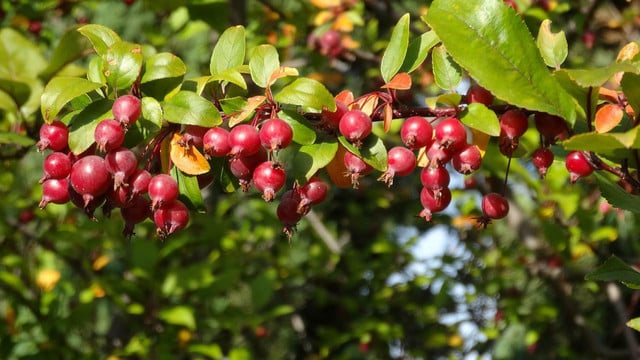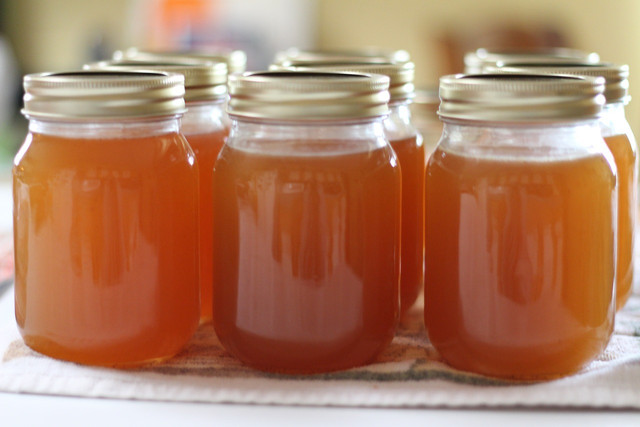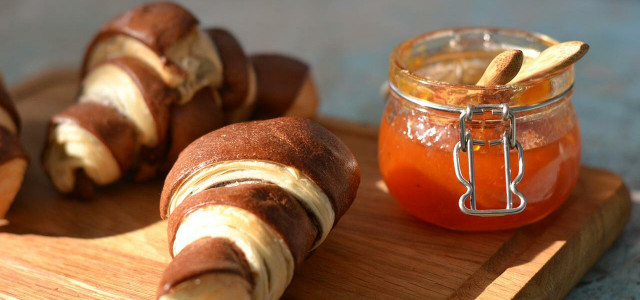Wondering what to do with a tree full of crabapples? Crabapple jelly is a simple, tasty, and free way to put these common, yet under-appreciated fruits to use.
Sweet, sour, and tangy crabapple jelly can add some needed personality to toast, waffles, or desserts without having to make a single purchase. Simply take a walk around the neighborhood or local park and you are likely to find a crabapple tree.
Crabapples easily grow wild and are commonly used as ornamental trees, so chances are that you’ve seen them without even noticing. These compact trees are popular for their flush of white or pink spring flowers, but the crabapples themselves usually litter the ground uneaten in the fall. Like edible weeds and regional edible flowers, crabapples are sustainable and local alternatives to fruit commercially grown using intensive farming methods.
Like regular apples, crabapples can range from yellow to red (flesh included), but they are typically much smaller: about the size of a cherry or plum. They taste tart and sour if eaten raw, so they are often cooked into crabapple jelly, jam, pies, or fermented into cider.
Tips for Making Crabapple Jelly

(Foto: CC0 / Pixabay / billslife2012)
Although canning isn’t an exact science, there are some steps you’ll need to ensure a properly set jelly:
- Taste-test the fruit before picking. Some varieties of crabapples can be too bitter and will produce an unpleasant crabapple jelly. If they make your mouth feel dry, then leave them alone. Always get permission if picking any fruit from someone else’s property.
- Jellies set from a combination of sugar, pectin, or lemon juice. Reducing one ingredient means that you must increase another, otherwise your jelly will stay liquid.
- Do a test to make sure your jelly is set: spoon a bit of the jelly onto a refrigerated plate. If it maintains its shape at room temperature and doesn’t run, then it is ready. Otherwise it needs more sugar, pectin, lemon juice, or heat.
- Sterilizing jars for canning is a necessary first step to prevent mold and extend shelf-life.
- Properly processing your crabapple jelly jars in boiling water will allow it last two years unopened at room temperature. Otherwise you can simply store it in the refrigerator for up to three months.
How to Make Crabapple Jelly



(Foto: CC0 / Pixabay / HomeMaker)
Crabapple jelly is a simple and tasty way to utilize these underappreciated fruits. Jelly is also a much more efficient way to use crabapples since there is no laborious peeling or coring required. Since crabapples are also naturally high in pectin, no additional pectin is needed unless you are opting for a low-sugar recipe.
Ingredients
- 3 lbs crabapples
- 3 cups water (or enough to just cover the crabapples)
- 3 cups white sugar
- lemon juice (only for lower sugar recipes)
Instruction
- Wash crabapples, discard any with blemishes, and cut in half. Toss into a pot and cover with water. Simmer the apples on medium-low for about 25-30 minutes, until they soften. Gently mash the mixture with a potato masher if it isn’t soft enough.
- Allow your mixture to cool and strain through a jellybag, cheesecloth, muslin, or colander. For a crystal clear jelly, avoid squeezing your jelly bag and instead hang it above a bowl to collect the juice overnight. Otherwise, you can gently squeeze all the juice out with your hands, which will yield a cloudy jelly, but will not impact flavor. Compost the leftover pulp.
- Heat up the strained crabapple juice and skim off any foam that forms. Once hot, stir in the sugar until fully dissolved. Bring to a rolling boil at medium-high heat and stir constantly for 2 minutes until it starts jelling.
- Ladle your crabapple jelly into clean, warm jars. Heat up your jars in hot water beforehand, otherwise they may crack from the hot jelly.
- At this point, you can further process your jars in hot water to extend storage time, or simply store in the refrigerator.
*For lower sugar recipes (2 cups instead of 3), add 1 tablespoon of lemon juice, and boil for longer until jelling starts (at least 5 minutes). For even lower sugar recipes (1 cup sugar), you will need added pectin for the crabapple jelly to set properly. Sure-Jell pectin is specially formulated for low-sugar recipes and can be found in most grocery stores, as well as on Amazon**.
**If you have a sieve, you can make a thicker crabapple jam by straining the pulp through the sieve instead of using only the juice.
Read more:
- Pickled Cherries Recipe to Preserve the Flavor
- Strawberry Syrup: A Simple Recipe
- How to Ferment Vegetables: A Beginner’s Guide
Do you like this post?







